Purdue has had 27 graduates become astronauts, 18 of whom have degrees from the School of Aeronautics and Astronautics.
Neil A. Armstrong
BS '55, Aeronautical Engineering, Purdue University
MS '70 Aerospace Engineering, University of Southern California
|
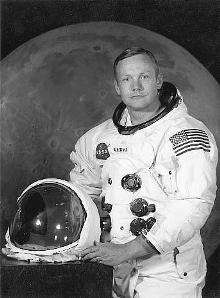
After serving as a naval aviator from 1949 to 1952 and completing his studies at Purdue,
Armstrong joined the National Advisory Committee for Aeronautics (NACA) in 1955. His first
assignment was with the NACA Lewis Research Center in Cleveland, Ohio. For the next 17 years,
he was an engineer, test pilot, astronaut and administrator for NACA and its successor agency,
the National Aeronautics and Space Administration (NASA).
As a research pilot at NASA's Flight Research Center, Edwards, Calif., he was a project
pilot on many pioneering high speed aircraft, including the well known, 4000-mph X-15. He has
flown over 200 different models of aircraft, including jets, rockets, helicopters and gliders.
Armstrong transferred to astronaut status in 1962. He was assigned as command pilot for the
Gemini 8 mission. Gemini 8 was launched on March 16, 1966, and Armstrong performed the first
successful docking of two vehicles in space.
In July 1969, as spacecraft commander of the historic Apollo 11 mission, Armstrong and
Buzz Aldrin landed their Lunar Module on the moon's Sea of Tranquility. Stepping onto the
lunar surface, Armstrong gave perhaps one of the Twentieth Century's most famous quotes,"That's one small step for man, one giant leap for mankind."
Armstrong subsequently held the position of Deputy Associate Administrator for Aeronautics, NASA
Headquarters Washington, D.C. In this position, he was responsible for the coordination and management of overall NASA research and technology work related to aeronautics. He was Professor of Aerospace Engineering at the University of Cincinnati from 1971-1979. During the years 1982-1992, Armstrong was chairman of Computing Technologies for Aviation, Inc., Charlottesville, Va.
Armstrong was a Fellow of the Society of Experimental Test Pilots and the Royal Aeronautical
Society; Honorary Fellow of the American Institute of Aeronautics and Astronautics, and the
International Astronautics Federation. He was a member of the National Academy of Engineering
and the Academy of the Kingdom of Morocco. He served as a member of the National Commission
on Space (1985-1986), as Vice-Chairman of the Presidential Commission on the Space Shuttle
Challenger Accident (1986), and as Chairman of the Presidential Advisory Committee for the Peace Corps.
Armstrong was decorated by 17 countries. He was the recipient of many special honors, including the Presidential Medal of Freedom; the Congressional Space Medal of Honor; the Explorers Club Medal; the Robert H. Goddard Memorial Trophy; the NASA Distinguished Service Medal; the Harmon International Aviation Trophy; the Royal Geographic Society's Gold Medal; the Federation Aeronautique Internationale's Gold Space Medal; the American Astronautical Society Flight Achievement Award; the Robert J. Collier Trophy; the AIAA Astronautics Award; the Octave Chanute Award; and the John J. Montgomery Award.
|
| |
Sirisha Bandla
BS '11, Aueronautical and Astronautical Engineering, Purdue University
MBA '15, George Washington University
|
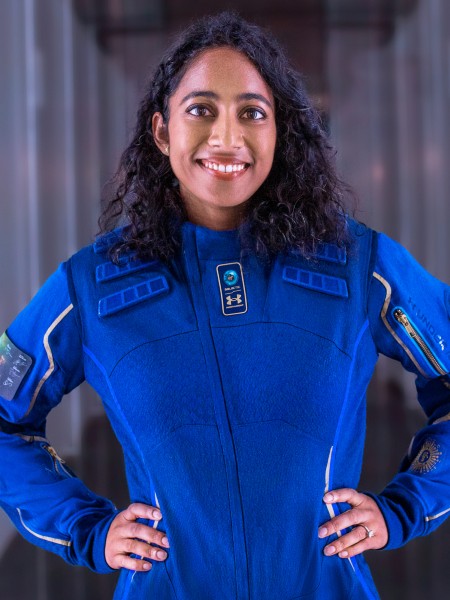
Sirisha Bandla is the Vice President of Government Affairs and Research Operations at Virgin Galactic. She was part of their first ever fully-crewed commercial spaceflight on July 11, 2021, joining Sir Richard Branson and fellow Purdue AAE alum Beth Moses. During the flight, Bandla conducted a zero-G experiment from the University of Florida to evaluate future human-tended research experiences.
|
| |
John E. Blaha (Colonel, USAF, Ret.)
BS '65, Engineering Science, U.S. Air Force Academy
MS '66, Aeronautics and Astronautics, Purdue University
|
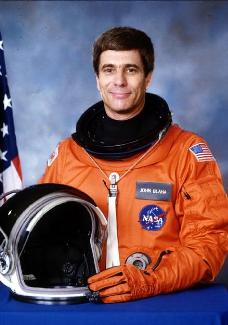
Blaha received his pilot wings at Williams Air Force Base, Arizona, in 1967. He was
subsequently assigned as an operational pilot flying F-4, F-102, F-106, and A-37 aircraft
(completing 361 combat missions in Vietnam). He attended the USAF Aerospace Research Pilot
School at Edwards Air Force Base, California, in 1971, and piloted the NF-104 research aircraft to 104,400 feet. Following graduation, he served as an F-104 instructor pilot at the test pilot school. In 1973, he was assigned as a test pilot working with the Royal Air Force at the Aeroplane and Armament Experimental Establishment, United Kingdom. In 1976 he attended the USAF Air Command and Staff College. After graduation, he was assigned to work for the Assistant Chief of Staff, Studies and Analyses, at Headquarters USAF in the Pentagon.
Selected as an astronaut in May 1980, Blaha has logged 161 days in space on 5 space missions.
He served as pilot on STS-29 Discovery, March 1989 and STS 33, Discovery, November 1989.
Blaha served as spacecraft commander on STS-43, Atlantis, August 1991 and STS-58, Columbia,
October/November 1993. Along with fellow Purdue alumnus Davis Wolf, this record fourteen-day life science research mission has been recognized by NASA as the most successful and efficient Space lab flight flown. Blaha began Russian language training in August 1994 and commenced an intensive training program at the Cosmonaut Training center, Star City, Russia in January 1995. He served as a mission specialist on STS-79, Atlantis, which launched on September 16, 1996. After docking, he transferred to the Mir Space Station.
Assigned as Board Engineer 2, he spent the following four months with the Mir 22 Cosmonaut crew conducting material sciences, fluid sciences and life science research, he returned to earth aboard STS-81 January 22, Columbia, 1997.
He has logged more than 7,000 hours of flying time in 34 different aircraft, and has written numerous technical articles on spacecraft performance and control.
John Blaha retired from NASA in September 1997 to return to his hometown of San Antonio, Texas, where he joined the Executive Management Group of the United Services Automobile Organization.
|
| |
Roy D. Bridges, Jr. (Colonel, USAF)
BS '65 Engineering Science, U.S. Air Force Academy
MS '66, Astronautics and Astronautics, Purdue University
|

Bridges is a distinguished graduate of the U.S. Air Force Academy, Colorado Springs,
CO, earning a bachelor's degree in engineering science in 1965. He received a Master of
Science degree in astronautics from Purdue University, IN, in 1966. Prior to his
assignment at Wright-Patterson Air Force Base, Bridges was the commander, Air Force
Flight Test Center, Edwards Air Force Base, CA. He has served in several key
leadership positions including deputy chief of staff, test and resources, Headquarters
Air Force Systems Command, Andrews Air Force Base, MD; commander, Eastern Space and
Missile Center, Patrick Air Force Base, FL; commander, 6510th Test Wing, Edwards Air Force Base, CA.
NASA selected Bridges as an astronaut candidate in 1980. He was the pilot on
STS-51-F, Challenger, during the July 1985 Spacelab-2 mission launched from
the Kennedy Space Center, Fla. This mission was the first pallet-only Spacelab mission
and the first mission to operate the Spacelab Instrument Pointing System (IPS). It carried
13 major experiments in the fields of astronomy, solar physics, ionospheric science, life
science, and a super fluid helium experiment. This mission was the Shuttles first "abort to
orbit", necessitated when one of Challenger's three main engines shut down during takeoff.
With the completion of this flight, Bridges has logged more than 188 hours in space.
The mission ended August 6, 1985, with a landing at Dryden.
Bridges is a retired U.S. Air Force Major General who served as the director of
requirements, Headquarters Air Force Materiel Command, Wright-Patterson Air Force
Base, OH, from June 1993 until his retirement July 1, 1996. In that position he
served as the command focal point for product management policy, processes and resources.
Bridges was the director of NASA's John F. Kennedy Space Center (KSC) from
March 2, 1997, to Aug. 9, 2003. As director, he was responsible for managing
NASA's only site for processing and launch of the Space Shuttle vehicle; processing
the payloads flown on both the Shuttle and expendable launch vehicles; and
overseeing expendable vehicle launches carrying NASA payloads.
He left KSC to become the director of the NASA's Langley Research Center in
Hampton, Va. As the senior management official of the laboratory employing
approximately 2,400 civil service personnel, Bridges is responsible for the
Center's aeronautical and space research programs, as well as facilities,
personnel and administration. He is also an advisor to the NASA Administrator
on Agency programs.
|
| |
Mark N. Brown (Colonel, USAF)
BS '73, Aeronautical and Astronautical Engineering, Purdue University
MS '80 Astronautical Engineering, U.S. Air Force Institute of Technology
|

Brown received his pilot wings at Laughlin Air Force Base, Texas, in 1974.
He was then assigned to the 87th Fighter Interceptor Squadron at K.I. Sawyer
Air Force Base, Michigan, where he flew both T-33 and F-106 aircraft. In 1979
Brown was transferred to the Air Force Institute of Technology at Wright-Patterson
Air Force Base, Ohio, and received his Master of Science degree in astronautical engineering in 1980.
Selected by NASA in May 1984, Brown became an astronaut in June 1985, and
qualified for assignment as a mission specialist on future Space Shuttle flight
crews. In December 1985, he was assigned to the crew of a Department of Defense
mission which was subsequently canceled due to the Challenger accident. During
1986 and 1987, he served as an astronaut member of the solid rocket booster redesign team.
On his first space flight, Brown served as a mission specialist on the
crew of STS-28. The Orbiter Columbia launched from Kennedy Space Center,
Florida, on August 8, 1989. The mission carried Department of Defense payloads
and a number of secondary payloads. After 80 orbits of the Earth, this five-day
mission concluded with a dry lakebed landing on Runway 17 at Edwards Air Force
Base, California on August 13, 1989. He then served as an astronaut member on
the Space Station Freedom Program.
Brown next flew on the crew of STS-48 aboard the Orbiter Discovery which
launched from Kennedy Space Center, Florida, on September 12, 1991. This was a
five-day mission where the crew deployed the Upper Atmosphere Research Satellite (UARS)
which is designed to provide scientists with their first complete data set on the
upper atmosphere's chemistry, winds and energy inputs. The crew also conducted
numerous secondary experiments ranging from growing protein crystals to studying
how fluids and structures react in weightlessness. The mission was accomplished
in 81 orbits of the Earth and concluded with a landing at Edwards Air Force Base,
California, on September 18, 1991. With the completion of his second mission, Brown
has logged over 249 hours in space.
Brown left NASA in July 1993 and retired from the U.S. Air Force to head up
the Space Division office of General Research Corporation in Dayton, Ohio.
|
| |
John H. Casper (Colonel, USAF, Ret.)
BS '66, Engineering Science, U.S. Air Force Academy
MS '67 Astronautics and Astronautics, Purdue University
|
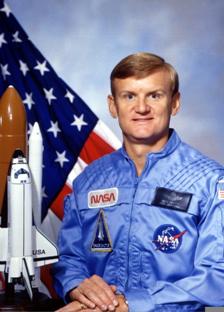
Col. Casper earned his pilot wings at Reese Air Force Base (AFB), Texas. He flew
229 combat missions with the 35th Tactical Fighter Wing at Phan Rang Air Base,
Vietnam. Following his tour in Vietnam, Col. Casper flew F-100 and F-4 aircraft
while assigned to the 48th Tactical Fighter Wing, Royal Air Force Lakenheath,
United Kingdom. Casper graduated from the USAF Test Pilot School at Edwards AFB,
California, and subsequently became Chief of the F-4 Test Team. Col. Casper was
then named Operations Officer and later Commander of the 6513th Test Squadron. He
was then assigned to Headquarters USAF at the Pentagon and was Deputy Chief of the
Special Projects Office. Col. Casper has logged over 10,000 flying hours in 52
different aircraft.
Selected by NASA in May 1984, Col. Casper became an astronaut in June 1985. A
veteran of four space flights, he has logged over 825 hours in space. He was the
pilot on STS-36 (1990), and was the spacecraft commander on STS-54 (1993), STS-62
(1994) and STS-77 (1996). His technical assignments while assigned to the Astronaut
Office included: Chief of the Operations Development Branch; lead for improvements
to the nose wheel steering, brakes, tires, and development of a landing drag chute;
astronaut team leader for the Shuttle Avionics Integration Laboratory (SAIL); and
ascent/entry spacecraft communicator (CAPCOM) in the Mission Control Center.
Following his last Shuttle mission in 1996, Col. Casper has served in
positions of increasing responsibility at the Johnson Space Center (JSC). He
currently serves as Manager, Space Shuttle Management Integration and Planning
Office. Previously, he was Deputy Manager, Return-To-Flight Planning Team, a NASA
Headquarters-chartered independent team charged with addressing all actions
necessary to comply with the Columbia Accident Investigation Board recommendations
and observations. After the Columbia accident in February 2003, Col. Casper
was assigned to the Mishap Investigation Team (MIT) as the JSC Center Director's
personal representative. He became the MIT Chairman's deputy for the Columbia debris
recovery operation, which involved directing the efforts of over 6,000 ground, air, and
water search personnel, as well as protection and impoundment of debris.
Col. Casper served as Director of Safety, Reliability, and Quality Assurance at
the NASA Johnson Space Center, where he was responsible for all safety, reliability
and quality activities for JSC's human spaceflight programs, including the International
Space Station, the Space Shuttle, Space Launch Initiative, and Crew Return Vehicles.
|
| |
Eugene A. Cernan (Captain, USN, Ret.)
BS '56 Electrical Engineering, Purdue University
MS '64 Aeronautical Engineering, U.S. Naval Postgraduate School
|
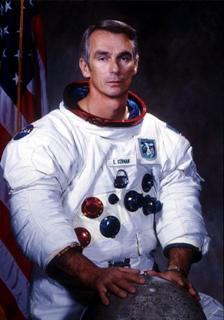
Cernan, a retired United States Navy Captain, received his commission through the Navy ROTC Program at Purdue. He
logged more than 5,000 hours flying time with more than 4,800 hours in jet aircraft and over 200 jet aircraft carrier landings.
Captain Cernan was one of 14 astronauts selected by NASA in October 1963. As pilot of the Gemini IX mission, Cernan
became the second American to walk in space. During this three-day flight that began on June 3, 1966, the crew used three
different techniques to effectly rendezvous with the previously launched Augmented Target Docking Adapter; and Cernan logged two hours and ten minutes outside the spacecraft in extravehicular
activities. Cernan subsequently served as backup pilot for Gemini 12 and as backup lunar module pilot for Apollo 7.
On his second space flight, he was lunar module pilot of Apollo 10, May 18-26, 1969, the first comprehensive
lunar-orbital qualification and verification flight test of an Apollo lunar module. This mission confirmed
the operations performance and descended to within 8 nautical miles of the lunar surface before returning to
the command module. In addition to demonstrating that man could navigate safely and accurately in the
moon's gravitational fields, Apollo 10 photographed and mapped tentative landing sites for future missions.
Cernan's next assignment was backup spacecraft commander for Apollo 14.
Cernan's last flight as spacecraft commander of Apollo 17 in 1972 saw the final manned lunar landing
to date. From the lunar base of operations at Taurus-Littrow, three highly successful excursions
to nearby craters and the Taurus Mountains were completed. This last mission to the moon established
several new records for manned space flight that include: longest manned lunar landing
flight (301 hours, 51 minutes); longest lunar surface extravehicular activities (22 hours, 6 minutes); largest
lunar sample return (an estimated 249 lbs.); and longest time in lunar
orbit (147 hours, 48 minutes). Cernan had the privilege and distinction of being the last man to
leave his footprints on the surface of the moon along with a plaque that reads, "Here Man Completed
His First Exploration of the Moon. December 1972 A.D. May The Spirit Of Peace In Which We Came Be Reflected
In The Lives Of All Mankind."
Captain Cernan logged 566 hours and 15 minutes in space, of which more than 73 hours were spent
on the surface of the moon.
|
| |
Roger B. Chaffee (Lieutenant Commander, USN)
BS '57 Aeronautical and Astronautical Engineering, Purdue University
|
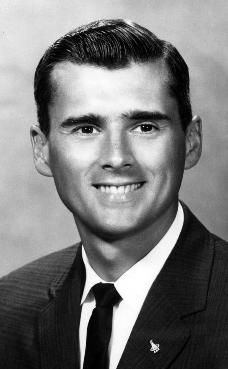
Chaffee completed his naval training on August 22, 1957 and was commissioned as an Ensign in the U.S. Navy. In
November 1957, he reported for military flight training in Pensacola, Florida where he learned to fly the
T-34 and T-28. He later was transferred to Kingsville, Texas, to train on the F9F Cougar jet. Chaffee completed
his flight training and won his wings in early 1959. Chaffee was given a variety of assignments and
participated in numerous training duties over the next few years. He worked extensively on the A3D
photo reconnaissance plane. Because of his complete understanding of the plane, he was granted
permission to fly it, thus becoming one of the youngest pilots allowed to fly an A3D.
Training in the Safety and Reliability School in California helped him in his duties as a
safety and quality control officer at the Heavy Photographic Squadron 62 at the Jacksonville,
Florida Naval Air Station. One of Chaffee's duties while serving with the V.A.P. 62 Squadron
was to photograph Cape Canaveral, which was gearing up to become the launch area for the newly
created manned space program. He also flew numerous flights to Cuba, often as many as three
a day. During one such mission, he took important aerial photographs that gave crucial
documentation of the Cuban missile buildup. When he was not flying for the Navy, he gave
private flying instructions to civilians in exchange for his personal use of their
plane. Additionally, he began taking graduate level courses in engineering.
NASA selected Chaffee in the third group of astronauts in October 1963. In addition
to participating in the overall training program, he also was tasked with working
on flight control communications systems, instrument systems and attitude and translation
control systems in the Apollo branch of the Astronaut office. In March 1966, he was
selected as one of the pilots for AS-204, the first three-man Apollo flight. NASA had named
Gus Grissom as Commander and Ed White as Senior Pilot. Chaffee would complete the
crew as Pilot. James McDivitt, David Scott and Russell Schweickart were assigned
as members of the back-up crew.
On January 27, 1967, a fire claimed the lives of Chaffee, fellow
Purdue graduate Grissom and White during a simulated launch of the spacecraft at
Cape Kennedy. After the disaster, the mission was officially designated as Apollo 1.
|
| |
Richard O. Covey (Colonel, USAF, Ret)
BS '68, Engineering Science, U.S. Air Force Academy
MS '69 Aeronautics and Astronautics, Purdue University
|

Between 1970 and 1974, Covey was an operational fighter pilot, flying the F-100, A-37, and
A-7D. He flew 339 combat missions during two tours in Southeast Asia. At Eglin Air Force
Base, Florida, between 1975 and 1978, he was an F-4 and A-7D weapons system test pilot and
joint test force director for electronic warfare testing of the F-15 Eagle. He has flown
over 5,700 hours in more than 30 different types of aircraft.
Selected as an astronaut in 1978, Covey has logged over 646 hours in space and is a veteran
of four space flights. He served as pilot on STS-51-I, Discovery, in August 1985, during
this seven-day mission, crew members deployed three communications satellites: the Navy SYNCOM IV-4,
the Australian AUSSAT, and American Satellite Company's ASC-1. The crew also performed the
successful on-orbit rendezvous and repair of the ailing 15,000-pound SYNCOM IV-3 satellite.
This repair activity involved the first manual grapple and manual deployment of a satellite
by a spacewalking crew member.
He next served as pilot on STS-26 September, 1988, Discovery, the first flight to be
flown after the Challenger accident. Mission duration was 97 hours during which crew
members successfully deployed the TDRS-C satellite and operated eleven secondary payloads
which included two student experiments.
On STS-38 Covey was the spacecraft commander of a five-man crew which launched at night from the
Kennedy Space Center, Florida, on November 15, 1990. During the five-day mission crew
members conducted Department of Defense operations. After 80 orbits of the Earth in
117 hours, Covey piloted the Space Shuttle Atlantis to a landing on the runway at
the Kennedy Space Center on November 20, 1990. This was the first Shuttle
recovery in Florida since 1985.
On his fourth flight, STS-61, Endeavour, December 1993, Covey commanded a
crew of seven on the Hubble Space Telescope (HST) servicing and repair mission. During
the 11-day mission, the HST was captured and restored to full capacity through a record
five space walks. After having traveled 4,433,772 miles in 163 orbits of the Earth,
Covey landed the Endeavour at night on the runway at the Kennedy Space Center on December 13, 1993.
|
| |
Andrew J. Feustel (PhD)
BS '89, Solid Earth Sciences, Purdue University
MS '91, Geophysics, Purdue University
PhD '95, Geological Sciences Queen's University, Ontario, Canada
|
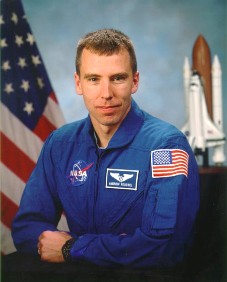
During his Master's degree studies Feustel worked as a Research Assistant and Teaching
Assistant in the Earth and Atmospheric Sciences Department of Purdue University. His M.S.
thesis investigated physical property measurements of rock specimens under elevated
hydrostatic pressures simulating Earth's deep crustal environments.
While at Purdue, Feustel served for three years as Grand Prix Chairman and team Kart driver for Sigma Phi Epsilon Fraternity. In 1991, Feustel attended Queen's University in Ontario, Canada where he worked as a Graduate Research Assistant and Graduate Teaching Assistant. Feustel's PhD thesis investigated seismicwave attenuation in underground mines and measurement techniques and applications to site characterization.
For three years he worked as a Geophysicist for the Engineering Seismology Group, Kingston, Ontario, Canada, installing and operating micro seismic monitoring equipment in underground mines throughout Eastern Canada and the United States. In 1997 Feustel began working for the Exxon Mobil Exploration
Company, Houston, Texas, as an Exploration Geophysicist designing and providing operational oversight of land, marine, and borehole seismic programs worldwide.
Selected as a Mission Specialist by NASA in July 2000, Dr. Feustel reported for training in August 2000. His training included five weeks of T-34 training at Naval Air Station VT-4, Pensacola, Florida. Following the completion of two years of training and evaluation, he was assigned technical duties in the Astronaut Office Space Shuttle and Space Station Branches.
Dr. Feustel served on the crew of STS-125 Atlantis from May 11-24, 2009, the final Space Shuttle mission to the Hubble Space Telescope. The mission successfully extended and improved the observatory's capabilities through 2014. In completing his first space mission, Feustel logged almost 13 days in space, and a total of 20 hours and 58 minutes in 3 EVAs. Feustel is currently assigned to the crew of STS-134 to the International Space Station. The mission will deliver the Alpha Magnetic Spectrometer (AMS), a state-of-the-art cosmic ray particle physics detector designed to examine fundamental issues about matter and the origin and structure of the universe.
He also served on the crew of STS-134 Endeavor from May 5 - June 1, 2011 as mission specialist. During the 14-day mission, Endeavour delivered the Alpha Magnetic Spectrometer (AMS) and spare parts including two S-band communications antennas, a high-pressure gas tank and additional spare parts for Dextre. This was the 36th shuttle mission to the International Space Station.
|
| |
Guy S. Gardner (USAF Ret.)
BS '69 Engineering Sciences, U.S. Air Force Academy
MS '70 Aeronautics and Astronautics, Purdue University
|

Guy Gardner is currently the Director of Super Project Development at Purdue University. Gardner
began his flying career flying F-4's in the Vietnam War while stationed at Udorn, Thailand in
1972. He then served as an F-4 instructor and operational pilot at Seymour Johnson Air
Force Base, North Carolina. He attended the USAF Test Pilot School at Edwards Air Force
Base in 1975, and served as a test pilot with the 6512th Test Squadron and as an instructor
test pilot at the USAF Test Pilot School. In 1979-80, he was operations officer of the 1st
Test Squadron at Clark Air Base, Philippines.
During his 11 years as a NASA astronaut, Guy worked in many areas of Space Shuttle and
Space Station development and support and flew as pilot on two Space Shuttle missions. He
first flew in space as pilot on the crew of STS-27, aboard the Orbiter Atlantis, on
December 2-6, 1988. The mission carried a Department of Defense payload. Guy next
flew as pilot on the crew of STS-35, aboard the Orbiter Columbia, on December 2-10 1990. The
mission carried the ASTRO-1 astronomy laboratory consisting of three ultraviolet
telescopes and one x-ray telescope.
After his second space flight, Guy returned to the Air Force as Head of the USAF Test
Pilot School at Edwards Air Force Base, California. In 1992, he retired from the Air Force
to rejoin NASA, this time at NASA Headquarters as the initial Program Director of the joint U.S.
and Russian Shuttle-Mir Program. He also served as Mission Director and Director of Quality Assurance.
In 1995, Guy joined the Federal Aviation Administration as Director of the William J. Hughes
Technical Center, at the Atlantic City Int'l Airport, in New Jersey. He then moved to
FAA Headquarters in 1996 as the Associate Administrator for Regulation and
Certification, leading the government organization responsible for oversight and
regulation of civil aviation safety. During the school years 1998-2001, Guy served
as a motivational/educational speaker to students across the country and as a high school
mathematics teacher at Washington-Lee High School in Arlington, Virginia, and
at The Potomac School in Fairfax County, Virginia. He also student taught physics
at Thomas Jefferson High School for Science and Technology in Fairfax County, Virginia.
Guy has recently served as Principal and Director of Omega Systems Group, a
risk management consulting company, and as Vice President for Space Flight
Development of Space Adventures, Ltd., a space tourism company.
|
| |
Virgil "Gus" Grissom (Lieutenant Colonel, USAF)
BS '50 Mechanical Engineering, Purdue University
|
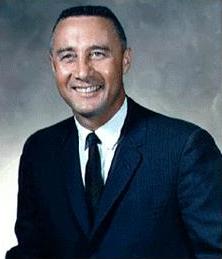
Lieutenant Colonel Virgil Ivan "Gus" Grissom was part of the U.S. manned
space program since it began in 1959, having been selected as one of NASA's
Original Seven Mercury Astronauts. After graduating from Purdue, Grissom re-enlisted in the
Air Force, finished air cadet training and won his wings. After
spending six months in Korea, Grissom completed 100 combat
missions with the 334th Fighter-Interceptor Squadron. His request
to fly 25 additional missions was denied, and he was sent
back to the USA, having earned both the Air Medal with cluster and
the Distinguished Flying Cross during his tour of duty. After receiving
additional instruction at the Institute of Technology at Wright-Patterson
AFB, Grissom attended test pilot school at Edwards AFB. He received his
test pilot credentials in 1957 and was transferred back to Wright-Patterson,
where he specialized in testing new jet fighters. On April 13, 1959, Air Force
Captain Grissom received official word that he had been selected as
one of the seven Project Mercury astronauts.
In July 1961, Grissom conducted a 15-minute sub-orbital flight aboard his
Mercury 4 capsule named Liberty Bell 7 and became the second American in
space. It was the first Mercury spacecraft to include a newly designed explosive
hatch. Although the hatch had not been tested previously, it was considered to be
superior in design to the older model used on Alan Shepard's capsule. The explosive hatch was held
in place by 70 bolts and was opened by triggering a Mild Detonating Fuse, or MDF. On splash
down, the hatch blew off before the retrieval line could be attached. The dramatic rescue of Grissom
could not include the recovery of his capsule, which sank to a depth of over
three miles. Technological breakthroughs made the recovery of the Liberty Bell 7 possible in 1999.
As command pilot of Gemini III in 1965, he participated in the United States' first two-person space
flight along with Lieutenant John W. Young, and the flight earned him the distinction of being the
first man to fly in space twice.
Grissom was named as Command pilot for the AS-204 mission, later known as Apollo 1, which
was to be the first three-man Apollo flight. On January 27, 1967, a flash fire claimed the
lives of Grissom, fellow Purdue graduate Roger Chaffee and Ed White, during a preflight test.
|
| |
Gregory J. Harbaugh
BS '78 Aeronautical and Astronautical Engineering, Purdue University
MS '86 Physical Science University of Houston
|
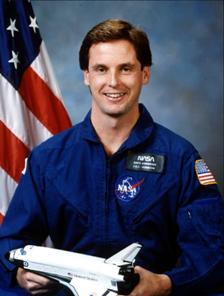
Harbaugh came to NASA's Johnson Space Center after graduation from Purdue University in
1978. He held engineering and technical management positions in Space Shuttle flight operations,
and supported Shuttle flight operations from Mission Control for most of the
flights from STS-1 through STS 51-L. He served as Lead Data Processing Systems (DPS)
Officer for STS-9 (Spacelab-1) and STS 41-D, Orbit DPS for STS 41-B and STS 41-C, and
Ascent/Entry DPS for STS 41-G. Mr. Harbaugh also served as a senior flight controller
addressing issues requiring real-time resolution, for several flights from STS 51-A through STS 51-L.
Selected by NASA in June 1987, Harbaugh became an astronaut in August 1988 and is a
veteran of four space flights. Harbaugh has logged a total of 818 hours in space, including 18
hours, 29 minutes EVA. His technical assignments included work in the Shuttle Avionics
Integration Laboratory (SAIL), the Shuttle Remote Manipulator System (RMS), and telerobotics systems development for
Space Station, the Hubble Space Telescope servicing mission development, spacecraft communicator (CAPCOM)
in Mission Control, and extravehicular activity (EVA) for the International
Space Station (ISS). He was assigned as the backup EVA crew member and capsule communicator (Capcom)
for STS-61, the first Hubble Space Telescope servicing mission.
He served as mission specialist aboard STS-39, Discovery, in April/May 1991,
and STS-54, Endeavour, in January 1993, where Harbaugh took part in a four-hour space
walk. STS-71, Atlantis, in June/July 1995, saw the first docking mission with the Russian Space
Station MIR, and involved a change of crews. Harbaugh served as Flight Engineer (Mission Specialist) and
was responsible for the in-flight operation of the docking system. STS-82 Discovery in February 1997
was the second Hubble Space Telescope (HST) servicing mission where the crew retrieved and secured the
HST in Discovery's payload bay. During this mission, Harbaugh took part in two of the five space walks
required to install new spectrometers and eight replacement instruments. HST was redeployed and
boosted to its highest orbit ever.
From 1997-2001 Harbaugh served as Manager of the Extravehicular Activity Project Office, with
program management responsibility for all aspects of NASA's spacewalk industry, including spacesuits,
tools, training, tasks and operations for the Space Shuttle, the International Space Station, and future planetary missions.
|
| |
Michael J. McCulley (Captain, USN, Ret.)
BS '70, MS '70, Metallurgical Engineering, Purdue University
|
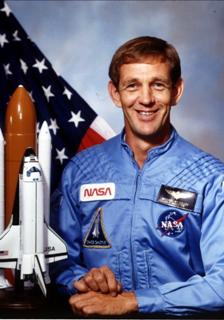
After graduation from high school, McCulley enlisted in the U.S. Navy and subsequently served on one
diesel-powered and two nuclear-powered submarines. In 1965 he entered Purdue University, and in January
1970, received his Naval Officers commission and both degrees. Following flight training, he was
selected to attend the Empire Test Pilots School in Great Britain. He served in a variety of test
pilots billets at the Naval Air Test Center, Patuxent River, Maryland, before returning to sea duty
on USS SARATOGA and USS NIMITZ.
Selected by NASA in May 1984, his technical assignments include: Astronaut Office weather coordinator;
flight crew representative to the Shuttle Requirements Control Board; Technical Assistant to the
Director of Flight Crew Operations; lead of the Astronaut Support Team at the Kennedy Space Center. He
was the pilot aboard STS-34, Atlantis, October 1989, where the crew successfully deployed the
Galileo spacecraft on its six-year journey to Jupiter, where it began its two-year exploration of
the planet and its moons. During this mission, the crew also operated the Shuttle Solar Backscatter
Ultraviolet Instrument (SSBUV) to map atmospheric ozone. He has logged a total of 119 hours and 41 minutes in space.
In October 1990, following his retirement from NASA and the Navy, McCulley was employed by Lockheed Martin
Space Operations and served as Vice President and Deputy Launch Site Director for the Kennedy Space
Center. He was promoted to Director in November 1995. McCulley next served as Vice President and
Associate Program Manager for United Space Alliance Ground Operations at the Kennedy Space Center
in Florida. Named to this position on June 1, 1996, he was responsible for directing the integration
of all processing activities associated with America's Space Shuttle program to ensure safe and
successful fulfillment of all company contractual commitments to NASA. He was promoted to Vice
President and Deputy Program Manager for the Space Flight Operations Contract (SFOC), where he
assisted USA's Vice President and Program manager in the management of the Space Shuttle Program
and, in November 1999, was named Chief Operating Officer (COO) of USA, responsible for the day-to-day operations and overall management of USA, the Prime Contractor for the Space Shuttle Program.
On May 15, 2003, Mike McCulley was named President and Chief Executive Officer of United Space
Alliance and is ultimately responsible for the direction, development and operations of the company.
|
| |
Beth Moses
BS '92, Aeronautics and Astronautics, Purdue University
MS '94, Aeronautics and Astronautics, Purdue University
|
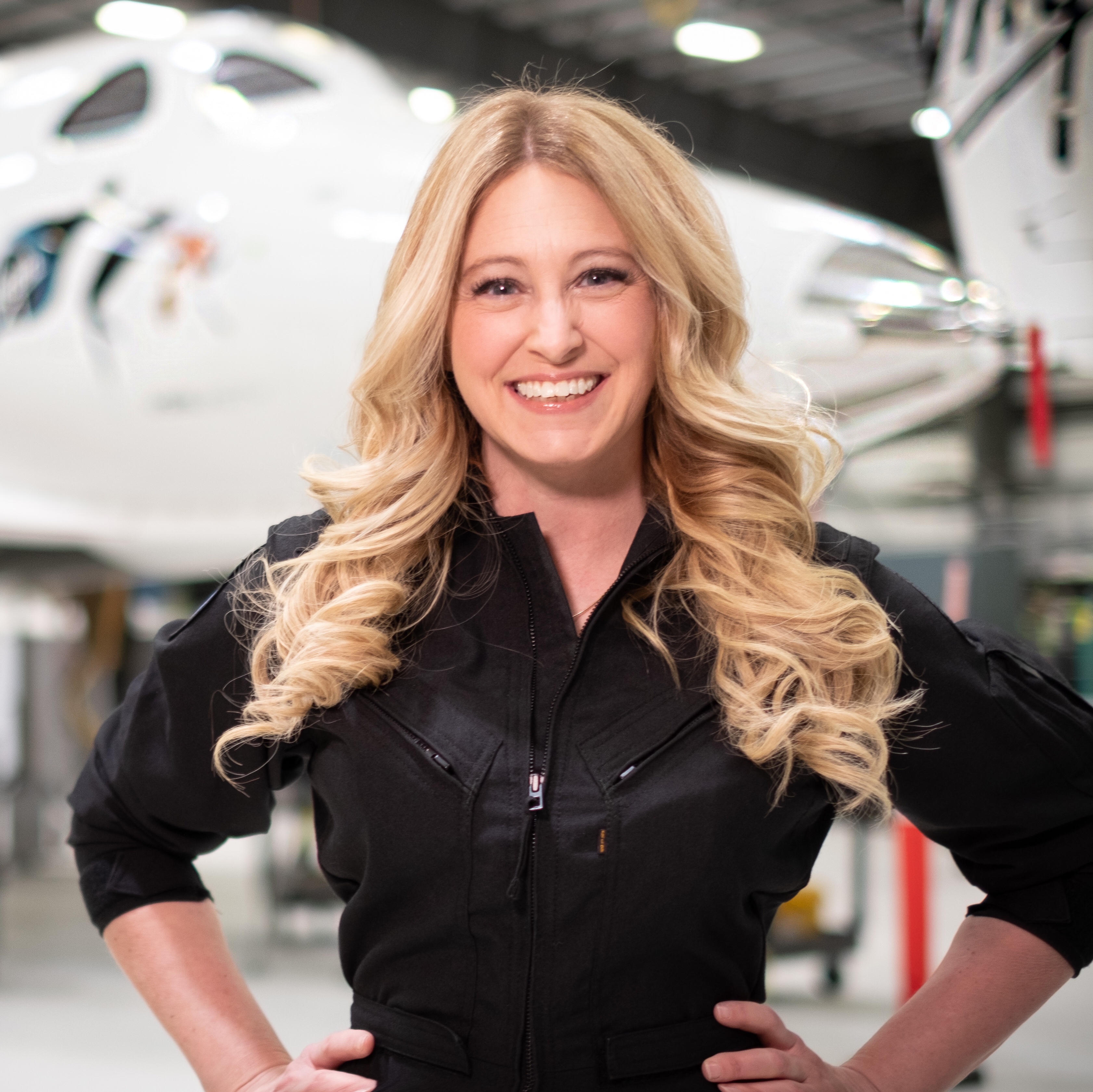
Beth Moses was the first woman to fly to space on a commercial vehicle and earned her Commercial Astronaut Wings from the Federal Aviation Administration in April 2019. She is the chief astronaut instructor at Virgin Galactic. Moses was formerly the Extravehicular System Manager for the International Space Station at NASA.
As a student at Purdue, she was awarded the National Science Foundation’s Microgravity Research Award to conduct materials research in parabolic flight. She is the recipient of Chicago’s Adler Planetarium annual Women in Space Science Award and a Google Science Fair judge. She was honored as an Outstanding Aerospace Engineer by AAE in 2018.
During her test flight on SpaceShipTwo, she became the first person ever to unbuckle and float around during a suborbital spaceflight. She made history again in 2021, joining fellow Purdue AAE alum Sirisha Bandla on the first ever fully-crewed commercial spaceflight.
|
Loral O'Hara
MS '09, Aeronautics and Astronautics, Purdue University
|

Loral O’Hara of Sugar Land, Texas, graduated from NASA's astronaut candidate program to its astronaut corps in January 2020 and became eligible for spaceflight assignment.
At the time of O'Hara selection to the astronaut class in June 2017, she was a Research Engineer at Woods Hole Oceanographic Institution (WHOI) in Woods Hole, Massachusetts, where she spent eight years working on the engineering and operations of underwater vehicles such as the human-occupied research submersible Alvin and the remotely operated vehicle Jason. Her experience includes mechanical design and analysis, systems engineering, manned submersible testing and certification, and vehicle operations. She participated in eleven research cruises aboard research vessels as a mechanical engineer and data processor.
She earned a Bachelor of Science degree in Aerospace Engineering at the University of Kansas and a Master of Science degree in Aeronautics and Astronautics from Purdue University.
|
Gary E. Payton (Major, USAF)
BS '71 Astronautical Engineering U.S. Air Force Academy
MS '72 Aeronautics and Astronautics, Purdue University
|
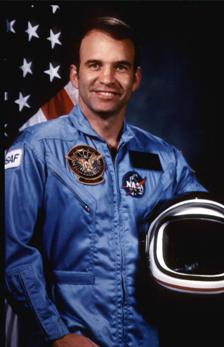
Payton graduated from high school in Rock Island, Illinois, in 1966; he then attended Bradley
University, Peoria, Illinois. From there he entered the USAF Academy, Colorado Springs, Colorado. He
received a Bachelor of Science degree in astronautical engineering, USAF Academy, 1971; and a Master
of Science degree in astronautical and aeronautical engineering, Purdue University, Lafayette, Indiana, in 1972.
He graduated from pilot training at Craig Air Force Base, Alabama, in 1973, and became an instructor
pilot there. He has accumulated 1,080 hours in T-37, T-38 and T-39 aircraft.
Payton was selected for the U.S.A.F. Manned Space Flight Engineer Program in February 1980, and in
January 1985, served on STS-51C, Discover which launched from and returned to land at the
Kennedy Space Center, Florida as payload specialist.
This was the first dedicated Space Shuttle Department of Defense mission and the classified payload
was successfully deployed and boosted into its operating orbit. At the conclusion of the mission,
Payton had traveled over 1.2 million miles in 48 Earth orbits, and logged more than 73 hours in
space. Payton has extensive experience in space launch program management, as well as in satellite
and aerospace engineering.
|
| |
Mark L. Polansky
BS '78, Aeronautical and Astronautical Engineering, Purdue University
MS'78 Aeronautics and Astronautics, Purdue University |
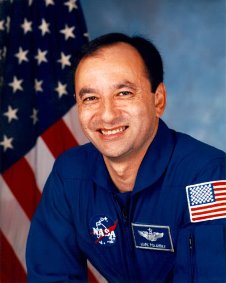
Polansky received an Air Force commission upon graduation from Purdue University in 1978. He
earned his pilot wings in January 1980 at Vance Air Force Base (AFB), Oklahoma. From 1980 to
1983, he was assigned to Langley AFB, Virginia, where he flew the F-15 aircraft.
In 1983, Polansky transitioned to the F-5E aircraft and served as an Aggressor Pilot, where
he trained tactical aircrews to defeat enemy aircraft tactics. He was assigned in this capacity
to Clark Air Base, Republic of the Philippines, and Nellis AFB, Nevada, until he was selected
to attend USAF Test Pilot School, Edwards AFB, California, in 1986. Upon graduation, he was
assigned to Eglin AFB, Florida, where he conducted weapons and systems testing in the F-15,
F-15E, and A-10 aircraft. Polansky left active duty in 1992 to pursue a career at NASA. He
has logged over 5,000 flight hours in over 30 different aircraft.
Polansky joined NASA in August 1992, as an aerospace engineer and research pilot. He was
assigned to the Aircraft Operations Division of the Johnson Space Center. His primary
responsibilities involved teaching the astronaut pilots Space Shuttle landing techniques
in the Shuttle Trainer Aircraft and instructing astronaut pilots and mission specialists
in the T-38 aircraft. Polansky also conducted flight testing of the NASA T-38 avionics upgrade aircraft.
Selected in April 1996 as an astronaut, Polansky completed two years of training and evaluation; he was initially assigned as a member of the Astronaut Support Personnel team at the Kennedy Space Center, supporting Space Shuttle launches and landings. Polansky also served as Chief of the CAPCOM Branch (April 2002 to December 2002), Chief Instructor Astronaut (April 2003 to January 2004) and Chief of the Return to Flight and Orbiter Repair Branches. A veteran of three space flight, Polansky has logged over 993 hours in space. He was the pilot on STS-98 and the mission commander on STS-116 and STS-127.
Polansky served as the pilot of STS-98, Atlantis, in February 2001, which continued the task of building and enhancing the International Space Station, by delivering and installing the U.S laboratory, Destiny. Polansky was responsible for the Shuttle's key propulsion, hydraulic and guidance systems during launch and landing. He was the extravehicular crewmember for the three space walks conducted during this mission and was also at the controls during the post-undocking fly around of the ISS. He was next assigned as a CAPCOM. Since April 2002 he has served as Chief of the CAPCOM Branch.
He then served on STS-116 Discovery from December 9-22, 2006. The seven-member crew on this 12-day mission continued construction of the ISS outpost by adding the P5 spacer truss segment during the first of four spacewalks. The next two spacewalks rewired the station's power system, preparing it to support the addition of European and Japanese science modules by future shuttle crews. The fourth spacewalk was added to allow the crew to coax and retract a stubborn solar panel to fold up accordion-style into its box. Discovery also delivered a new crew member and more than two tons of equipment and supplies to the station. Almost two tons of items no longer needed on the station returned to Earth with STS-116. Mission duration was 12 days, 20 hours and 45 minutes.
Most recently, Polansky served on STS-127, ISS Assembly Mission 2J/A, Endeavour from July 15-31, 2009 and delivered the Japanese-built Exposed Facility (JEM-EF) and the Experiment Logistics Module Exposed Section (ELM-ES) to the International Space Station. The crew completed the construction of the KIBO Japanese Experiment Module, installed scientific experiments on its Exposed Facility and delivered critical spare parts and replacement batteries to the orbital complex, in addition to transferring 24,638 pounds of hardware and 1,225 pounds of water to the station. While the Shuttle was docked to the station, the mission featured a record 13 astronauts working aboard the Station representing all five ISS partners -- NASA, the Russian Space Agency, the Canadian Space Agency, the European Space Agency and the Japanese Space Agency (JAXA). The 16 day mission included 5 spacewalks and was accomplished in 248 orbits of the Earth, traveling 6,547,853 million miles in 15 days, 16 hours, 44 minutes and 58 seconds.
|
| |
Audrey Powers
BS '99, Aeronautical and Astronautical Engineering, Purdue University
JD '08, Santa Clara University School of Law |
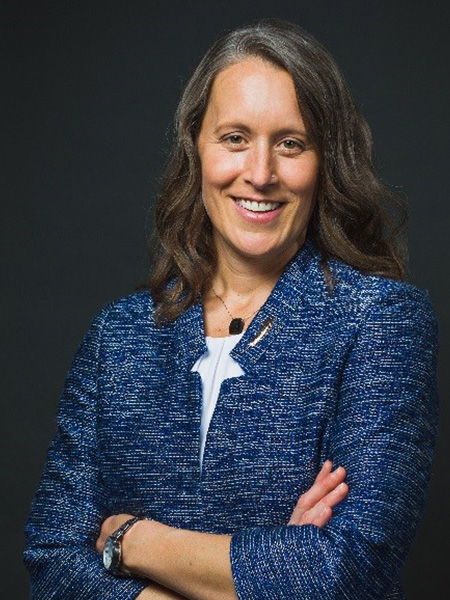
Audrey Powers joined Blue Origin in 2013 and oversees all New Shepard flight operations, vehicle maintenance, and launch, landing, and ground support infrastructure. In collaboration with New Shepard's Safety & Mission Assurance team, Test & Flight Operations, Chief Engineers, and external partners, she played a lead role in the multi-year process to certify New Shepard for human flight. Prior to leading New Shepard's Mission and Flight Operations team, she served as Deputy General Counsel and Vice President of Legal & Compliance for Blue Origin, overseeing a wide variety of legal, regulatory and policy matters. Audrey worked as an engineer for almost a decade before becoming a lawyer. As a guidance and controls engineer, she was a flight controller for NASA with 2,000 hours of console time in Mission Control for the International Space Station Program. In 2021, she accompanied William Shatner on the second human spaceflight of Blue Origin's New Shepard spacecraft.
|
| |
Jerry L. Ross (Colonel, USAF, Ret.)
BS '70, MS '72, Mechanical Engineering, Purdue University
|

Ross, an Air Force ROTC student at Purdue University, received his commission upon graduation
in 1970. After receiving his master's degree from Purdue in 1972, he entered active duty with
the Air Force and was assigned to the Ramjet Engine Division of Air Force Aero-Propulsion
Laboratory at Wright-Patterson Air Force Base, Ohio. Ross graduated from the USAF Test Pilot
School's Flight Test Engineer Course in 1976 and was subsequently assigned to the 6510th
Test Wing at Edwards Air Force Base, California.
Ross has flown in 21 different types of aircraft, holds a private pilot's license, and
has logged over 3,900 flying hours, the majority in military aircraft. He retired from
the Air Force on March 31, 2000. In February 1979, Ross was assigned to the Payload
Operations Division at the Lyndon B. Johnson Space Center as a payload officer/flight
controller, responsible for the flight operations integration of payloads into the Space Shuttle.
Ross was selected as an astronaut in May 1980. A veteran of seven space flights and nine-space
walks, Ross has broken the record books for the most space flights undertaken by any astronaut
in history. Ross flew as mission specialist on STS-61-B Atlantis, November 1985; STS-27 Atlantis,
December 1988; and STS-37 Atlantis, April 1991, which deployed the 35,000-pound Gamma Ray
Observatory. He served as Payload Commander/Mission Specialist on STS-55 Columbia, April/May 1993,
and again served as Mission Specialist on STS-74 Atlantis, November 1995, which was the second
Space Shuttle to rendezvous and dock with the Russian Space Station MIR. His sixth flight was aboard
STS-88, Endeavour, December 1998, this was the first International Space Station assembly
mission, during which he conducted three-space walks. His record breaking seventh flight, STS-110
Atlantis April 2002 took his total space walk time to 58 hours, 18 minutes which set a
new record for U.S. space walks. During this mission the crew installed the centerpiece of the
International Space Station's main truss and completed the inaugural run of the first space
railcar, the 1,900-pound Mobile Transporter. The Mobile Transporter moves at a maximum
speed of one inch per second and provides a platform for the station's robotic arm
to ride along rails attached to the truss to assist in future assembly and maintenance of the station.
Ross currently serves as Chief, Vehicle Integration Test Office at Johnson Space Center and
is the Chief Astronaut, NASA Engineering and Safety Center (NESC).
|
| |
Loren J. Shriver (Colonel, U.S.A.F)
BS '67, Aeronautical Engineering, U.S. Air Force Academy
MS '68, Aeronautics and Astronautics, Purdue University
|

Shriver received a Master of Science degree in Astronautical Engineering from Purdue
University in 1968. From 1969 to 1973, he served as a T-38 academic instructor pilot
at Vance Air Force Base, Oklahoma. He was assigned to an overseas tour in Thailand
until October 1974. He was assigned to the 6512th Test Squadron at Edwards Air Force
Base, and participated in the Air Force development test and evaluation of the T-38
lead-in fighter. In 1976, Shriver began serving as a test pilot for the F-15 Joint
Test Force at Edwards Air Force Base.
He has flown in 30 different types of single and multiengine civilian and military
fixed-wing and helicopter aircraft, has logged over 6,200 hours in jet aircraft,
and holds commercial pilot and private glider ratings.
Shriver was selected as an astronaut by NASA in January 1978. He is a veteran of
three space flights with over 386 hours in space. In September of 1982, he was
selected as pilot for STS-10. That mission was later canceled. Shriver was pilot
of STS-51C which launched from Kennedy Space Center, Florida, on January 24, 1985. STS-51C
performed its Department of Defense mission which included deployment of a modified
Inertial Upper Stage (IUS) vehicle from the Space Shuttle's payload bay.
On his second mission, Shriver commanded a crew of five. STS-31 launched on
April 24, 1990. During the 5-day mission, crew members deployed the Hubble
Space Telescope (HST) and conducted a variety of middeck experiments involving
the study of protein crystal growth, polymer membrane processing, and the
effects of weightlessness and magnetic fields on an ion arc. They also
operated a variety of cameras, including both the IMAX in-cabin and cargo
bay cameras for Earth observations from their then record-setting altitude
of 333 nautical miles.
Shriver was spacecraft commander of STS-46, July 31, 1992 which was an 8-day mission, during
which crew members deployed the European Retrievable Carrier (EURECA) satellite (an
ESA-sponsored free-flying science platform), and conducted the first Tethered Satellite
System (TSS) test flight (a joint project between NASA and the Italian Space Agency).
|
| |
Scott D. Tingle
BS '87, Mechanical Engineering, Southern Massachusetts University
MS '88, Mechanical Engineering, Purdue University
|
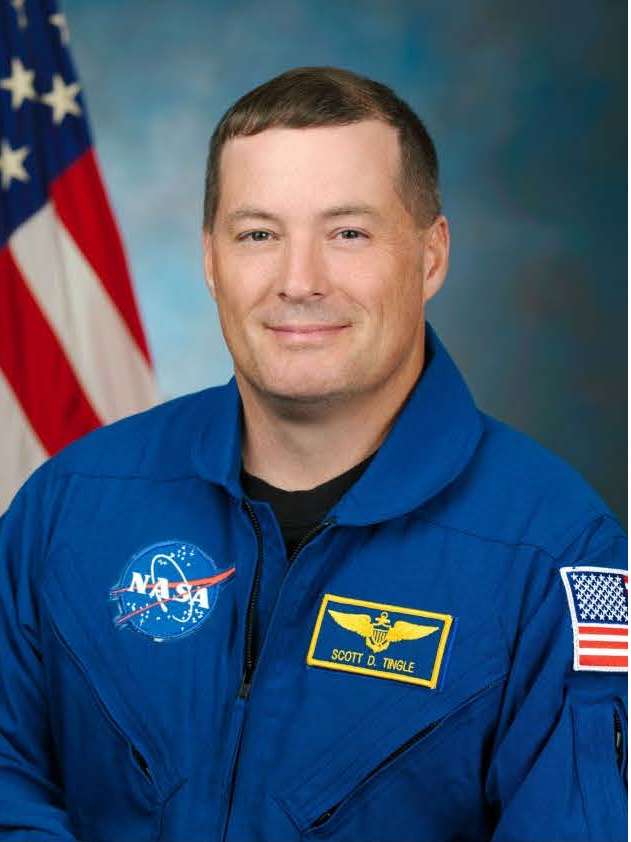
Following graduate school, Tingle spent 3 years with the Aerospace Corporation, El Segundo, California, as a member of technical staff in their Propulsion Department. He was commissioned as a naval officer in 1991 and earned his wings of gold as a naval aviator in 1993. He began his operational flying career in 1994 with the Blue Diamonds of VFA-146 based from Lemoore, California. He deployed to the Western Pacific and North Arabian Gulf with Carrier Air Wing Nine aboard USS Nimitz. Following graduation from Navy Test Pilot School in 1998, he performed as an operational test pilot for the FA-18E/F Super Hornet program with the Vampires of VX-9, located at China Lake, California. Tingle then completed a CAG Paddles tour flying FA-18A/C Hornets with Carrier Air Wing Eleven (CVW-11) aboard USS Carl Vinson. CVW-11 and USS Carl Vinson were among the first responders following the attacks of September 11, 2001. After a tour as assistant operations officer with the Strike Fighter Wing Pacific and instructor pilot with VFA-122, he completed a department head tour as safety officer, maintenance officer and operations officer while flying the FA-18A Hornet with the Warhawks of VFA-97 (Lemoore, California). Tingle completed a deployment with CVW-11 to the Western Pacific/North Arabian Gulf and also deployed with Marine Air Group Twelve (MAG-12) to Iwakuni, Japan. In 2005, Tingle returned to Patuxent River, Maryland, as the ship suitability department head and test pilot with the Salty Dogs of VX-23. Here he tested FA-18C Hornet, FA-18E/F Super Hornet and EA-18G Growler aircraft and certified aircraft carrier precision landing systems. Tingle was attached to PMA-201 as the lead systems engineer for the Standoff Land Attack Missile (SLAM) and Harpoon weapon systems when selected as an astronaut candidate. He has accumulated more than 3,500 flight hours in 48 types of aircraft, 700 carrier arrestments and 54 combat missions in Iraq and Afghanistan.
Tingle is a member of the Society of Experimental Test Pilots, Experimental Aircraft Association, American Institute of Aeronautics and Astronautics, Tailhook Association, U.S. Navy Test Pilot School Alumni Association, Purdue University Alumni Association, University of Massachusetts Alumni Association, Save the Children.
He has received numerous awards, including a Meritorious Service Medal, three Air Medals, six Navy Commendation Medals, including a Combat V, four Navy and Marine Corps Achievement Medals and various unit commendations. Graduated magna cum laude from Southeastern Massachusetts University. Outstanding Graduate of U.S. Navy Test Pilot School Class 113.
Tingle was selected in July 2009 as one of 14 members of the 20th NASA Astronaut Candidate Training. Training included scientific and technical briefings, intensive instruction in International Space Station systems, Extravehicular Activity (EVA), robotics, physiological training, T-38 flight training and water and wilderness survival training. He graduated in 2011.
|
Janice E. Voss (PhD)
BS '75, Engineering Science, Purdue University
MS '77, Electrical Engineering, Massachusetts Institute of Technology
PhD '87, Aeronautics and Astronautics, Massachusetts Institute of Technology
|
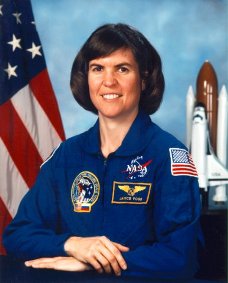
Selected by NASA in January 1990, Dr. Janice Voss became an astronaut in July 1991. She qualified
for flight assignment as a mission specialist.
A veteran of five space flights, Voss logged over 49 days in
space, traveling 18.8 million miles in 779 Earth orbits. She first flew on
STS-57, Endeavour, June/July 1993, as mission specialist. She also flew on
STS-63, Discovery, February 1995, which rendezvoused with the Russian Space Station MIR.
Voss then flew as payload commander on STS-83, Columbia, April 1997. When this
mission was cut short due to problems with one of the Shuttle's three fuel cell
power generation units, the entire crew and payload flew on STS-94, Columbia, July 1997. This
mission focused on materials and combustion science research in micro gravity.
She also served on STS-99, Endeavour, February 2000, which was, an 11-day flight during which the international crew worked dual shifts to support radar-mapping operations. The Shuttle Radar Topography Mission mapped more than 47 million miles of the Earth's land surface, and gathered the most comprehensive three-dimensional map of the Earth's surface to date.
Her technical assignments included working Spacelab/Spacehab issues for the Astronaut Office Mission Development Branch, and robotics issues for the Robotics Branch. From October 2004 to November 2007, she was assigned to the NASA Ames Research Center, where she served as the Science Director for the Kepler spacecraft.
|
| |
Charles D. Walker
BS '71 Aeronautical and Astronautical Engineering, Purdue University
|

Following graduation from Purdue University, Charles Walker worked as a civil engineering technician,
land acquisition specialist and forest firefighter for the U.S. Forest Service. Walker
joined the McDonnell Douglas Corporation in 1977 as a test engineer on the Aft Propulsion
Subsystem for the Space Shuttle orbiters. He joined the Space Manufacturing (later named
Electrophoresis Operations in Space, EOS) team as one of its original members. He shares
in a patent for the McDonnell Douglas developed continuous flow electrophoresis (CFES) device.
From 1979-86, he was Chief Test Engineer and Payload Specialist for the McDonnell
Douglas EOS commercialization project. Walker led the EOS laboratory test and operations
team developing biomedical products. His contributions to the program included engineering
planning, design and development, product research, and space flight and evaluation of the CFES device.
He was involved with the program support activities at Kennedy Space Center, Florida, and
at the Mission Control Center in Houston, Texas. He was responsible for training the
NASA astronaut crews in the operation of the CFES payload on STS-4, STS-6, STS-7, and
STS-8 shuttle flights during 1982 and 1983.
Confirmed by NASA in 1983 as the first industrial payload specialist, Walker accompanied
the McDonnell Douglas CFES equipment as a crewmember on mission STS-41-D, Discovery,
August/September 1984. His assignment was to monitor the company's continuous-flow electrophoresis
system. He made his second flight on STS-51-D, Discovery, in April 1985.
His third flight on STS-61-B, Atlantis, in November 1985, saw the first construction
project in space as crewmembers tested building methods in preparation for the
construction of the space station. He accumulated over 20 days in space and traveling 8.2 million miles.
In May 1986, Walker was appointed Special Assistant to the President of McDonnell
Douglas Space Systems Company; working in Washington, D.C. In 1999, Walker was
appointed Senior Manager of Space Programs Business Development and Marketing with
The Boeing Company Washington D.C. Operations.
|
| |
Mary Ellen Weber (PhD)
BS '84, Chemical Engineering, Purdue University
PhD '88 Physical Chemistry, University of California, Berkeley
|

During her undergraduate studies at Purdue, Dr. Weber was an engineering intern at Ohio
Edison, Delco Electronics, and 3M. Following this, in her doctoral research at Berkeley, she
explored the physics of gas-phase chemical reactions involving silicon. She then joined Texas
Instruments to research new processes for making computer chips. TI assigned her
to a consortium of semiconductor companies, SEMATECH, and subsequently to Applied
Materials, to create a revolutionary reactor for manufacturing next-generation
chips. She has received one patent and published eight papers in scientific journals.
Dr. Weber was selected by NASA in the fourteenth group of astronauts in 1992. During her 10-year career
with NASA, she held myriad positions. She worked extensively in technology commercialization, and as
part of a team reporting to NASA's chief executive, she worked directly with a venture capital firm
to successfully identify and develop a business venture leveraging a space technology. In addition,
Dr. Weber was the Legislative Affairs liaison at NASA Headquarters in Washington D.C., interfacing
with Congress and traveling with NASA's chief executive. Prior to this appointment, she was
Chairman of the procurement board for the Biotechnology Program contractor, and she also served
on a team that revamped the $2 billion plan for Space Station research facilities. Dr. Weber's
principal technical assignments within the Astronaut Office included participating in critical
launch, landing, and test operations at the Kennedy Space Center, testing Shuttle flight
software, and developing with international space agencies the training protocols and
facilities for experiments aboard the Space Station. A veteran of two space flights, STS-70 and STS-101,
she has logged over 450 hours in space. STS-70, Discovery, July 1995, successfully delivered
into orbit, a critical NASA communications satellite, TDRS-G. Dr. Weber's primary responsibility was
checking the systems of the satellite and sending it into its 22,000-mile orbit above the equator. She
also performed biotechnical experiments and was the primary contingency space walk crewmember
and medical officer. STS-101, Atlantis, May 2000, was the third Shuttle mission devoted to the
construction of the International Space Station. Dr. Weber's two primary responsibilities were
operating the 60-foot robotic arm to maneuver a space walk
crewmember along the Station surface, and directing the transfer of over three thousand pounds of equipment.
She resigned from NASA in December 2002. She is
also an active speaker on topics of performance, risk, and success, and a speaking consultant and coach.
|
| |
Donald E. Williams (Captain, USN, Ret.)
BS '64 Mechanical Engineering, Purdue University
|

Williams received his commission through the NROTC program at Purdue University. He completed
flight training at Pensacola, Florida; Meridian, Mississippi; and Kingsville, Texas, receiving
his wings in May 1966. After A-4 training, he made two Vietnam deployments aboard the
USS ENTERPRISE with Attack Squadron 113. He served as a flight instructor in Attack
Squadron 125 at Naval Air Station Lemoore, California, for 2 years and transitioned
to A-7 aircraft. He made two additional Vietnam deployments aboard the USS ENTERPRISE
with CVW-14 staff and Attack Squadron 97. Williams completed a total of 330 combat missions.
In 1973, Williams attended the Armed Forces Staff College. He graduated from the U.S.
Naval Test Pilot School at Patuxent River, Maryland, in June 1974, and was assigned
to the Naval Air Test Center's Carrier Suitability Branch of Flight Test Division. From
August 1976 to June 1977, following reorganization of the Naval Air Test Center, he
was head of the Carrier Systems Branch, Strike Aircraft Test Directorate. He reported
next for A-7 refresher training and was assigned to Attack Squadron 94 when selected
by NASA. He has logged more than 6,000 hours flying time, which includes 5,700 hours
in jets and 745 carrier landings.
Selected by NASA in 1978, Williams is a veteran of two space flights. He served as
pilot on STS-51D, Discovery, April 1985. During the mission, the crew deployed
ANIK-C for Telesat of Canada and Syncom IV-3 for the U.S. Navy. A malfunction
in the Syncom spacecraft resulted in the first unscheduled EVA, rendezvous and
proximity operations for the Space Shuttle in an attempt to activate the satellite.
Additional, the crew also conducted several medical experiments, two student
experiments, activated two Getaway Specials, and filmed experiments with toys in space.
As spacecraft commander on STS-34, Atlantis, October 1989, during the mission the crew
successfully deployed the Galileo spacecraft, starting its journey to explore Jupiter,
operated the Shuttle Solar Backscatter Ultraviolet Instrument (SSBUV) to map
atmospheric ozone, and performed numerous secondary experiments involving radiation
measurements, polymer morphology, lightning research, microgravity effects on
plants, and a student experiment on ice crystal growth in space.
|
| |
David A. Wolf (MD)
BS '78 Electrical Engineering, Purdue University
MD '82 Indiana University
|

Dr. Wolf is a USAF senior flight surgeon in the Air National Guard (1982 to present). In 1983, Dr. Wolf joined the Medical Sciences Division, Johnson Space Center Houston, TX. He was responsible for development of the American Flight Echocardiograph for investigating cardiovascular physiology
in microgravity. Upon completion he was assigned as chief engineer for design of the Space Station medical facility. In 1986 he was assigned to direct development of the Space Bioreactor and associated tissue engineering and cancer research applications. This utilized controlled gravitational conditions for in-vitro growth of human tissue, resulted in development of the state of the art NASA rotating tissue culture systems for use on Earth and in Space.
Selected as a NASA astronaut in January 1990, Dr. Wolf became qualified for space flight in July 1991. His technical assignments have included Orbiter vehicle processing and test at Kennedy Space Center (1991-1992) and spacecraft communications (CAPCOM) (1994-1995). He was CAPCOM for the first and third Shuttle-Mir rendezvous.
Dr. Wolf's first flight was as mission specialist aboard STS- 58, Columbia, October 16 - November 1, 1993 and along with fellow Purdue alumnus John Blaha, this was recognized by NASA as the most successful and efficient Space Lab flight flown. This spaceflight was a key milestone in a 15 year Academic and Governmental collaboration resulting in an extensive understanding of human physiological adaptation to space and return to Earth. Dr. Wolf was responsible to work alongside leading Academic investigators to enable this mission, conduct the flight, and interpret results. The team conducted neurovestibular, cardiovascular, cardiopulmonary, metabolic, and musculoskeletal research, revealing fundamental human physiology otherwise masked by earth gravity. This information plays a pivotal role in enabling more extensive human exploration of Space.
Dr. Wolf commenced training at the Cosmonaut training center in Star City, Russia in preparation for a long-duration stay aboard MIR. He launched aboard Space Shuttle, Atlantis, September 25, 1997 as part of the crew of STS-86. Following docking, he transferred to the Space Station MIR and spent the next 119 days aboard serving as Board Engineer 2. He returned with the crew of STS-89 aboard the Shuttle Endeavour on January 31, 1998.
Wolf then served on STS-112 from October 7-18 2002 an International Space Station assembly mission which delivered the first starboard truss segment. This provided major components of the ISS permanent cooling, communications, and structural components. As lead spacewalker (EV1) he was responsible to lead the EVA team in assuring success of this ambitious on-orbit spacecraft construction activity. Notably, unusual real time adaptability, to overcome a complete Shuttle robotics arm failure, was demonstrated during a critical systems activation spacewalk. He also served as rendezvous navigation specialist, entry flight deck crew, and multiple orbiter sub-system specialist. Mission duration was 10 days, 19 hours, and 58 minutes during which he performed 3 spacewalks totaling approximately 18 hours.
Most recently, Wolf served on STS-127, ISS Assembly Mission 2J/A, Endeavour from July 15-31, 2009 and delivered the Japanese-built Exposed Facility (JEM-EF) and the Experiment Logistics Module Exposed Section (ELM-ES) to the International Space Station. The crew completed the construction of the KIBO Japanese Experiment Module, installed scientific experiments on its Exposed Facility and delivered critical spare parts and replacement batteries to the orbital complex, in addition to transferring 24,638 pounds of hardware and 1,225 pounds of water to the station. While the Shuttle was docked to the station, the mission featured a record 13 astronauts working aboard the Station representing all five ISS partners -- NASA, the Russian Space Agency, the Canadian Space Agency, the European Space Agency and the Japanese Space Agency (JAXA). The 16 day mission included 5 spacewalks and was accomplished in 248 orbits of the Earth, traveling 6,547,853 million miles in 15 days, 16 hours, 44 minutes and 58 seconds.
Dr. Wolf retired from NASA in December 2012.
|